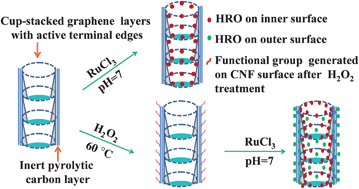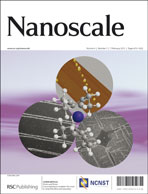We demonstrate a new strategy for the fabrication of supercapacitor electrodes possessing high mass and area-specific capacitance for efficient charge storage, which can be extremely useful for the development of light, compact and high performance supercapacitors for a variety of high power demanding applications. High mass and electrode area specific capacitances were attained by using Hydrous Ruthenium Oxide (HRO)–Carbon Nanofiber (CNF) hybrid electrodes prepared by the deposition of HRO (∼31% Ru content) on both the outer and inner surfaces of a cylindrical hollow CNF having open tips. Electrochemical studies of the uniformly deposited HRO nanoparticles on the CNF surface showed a mass specific capacitance of 645 F g−1 and an electrode specific capacitance of 1.29 F cm−2 with a HRO–CNF material loading of 2 mg cm−2 in the supercapacitor electrodes. The mass specific capacitance of pure HRO is 301 F g−1, whereas the mass specific capacitance of HRO in the HRO–CNF electrode is ∼1300 F g−1, which is very close to the theoretical capacitance of HRO. This enhanced charge storage ability, high rate capability, better cyclic stability and low ESR of the HRO–CNF will be useful for the development of high performance supercapacitors.

You have access to this article
 Please wait while we load your content...
Something went wrong. Try again?
Please wait while we load your content...
Something went wrong. Try again?


 Please wait while we load your content...
Please wait while we load your content...